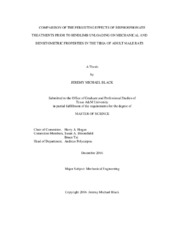| dc.description.abstract | Bisphosphonates have been shown to be an effective method to treat detrimental bone loss that is associated with osteoporosis. In microgravity, astronauts experience mechanical unloading of the skeleton. This can cause detrimental bone loss. Bisphosphonates offer astronauts a pharmacological method to combat the negative effect of space flight. This study looked at the effectiveness of two bisphosphonate drug treatments administered prior to hindlimb unloading (HU) and their effect as a countermeasure to disuse induced bone loss and recovery following reambulation.
The model used to mimic space flight was the adult HU rat model, specifically 6-month old, male, Sprague-Dawley rats. The rats underwent 28 days of pre-treatment, 28 days of HU and 56 days of recovery. The rats were divided into four treatment groups. The groups included an age-matched control group (AC) that did not undergo HU. The other groups that underwent HU were hindlimb unloaded control (HUC), alendronate pre-treated (ALN), and risedronate pre-treated (RIS). The effects of pre-treatment and the differences between the two drugs were explored. Data were collected ex vivo from left tibia using peripheral Quantitative Computed Tomography (pQCT) and mechanical testing at both the proximal metaphysis and the mid-diaphysis.
The results of this study showed that bisphosphonates were able to prevent the bone loss that was seen in the HUC animals, and maintain bone at levels that were not statistically different from AC. Metaphysis pQCT scans showed that the drugs were able to significantly combat losses due to HU and were specifically effective in the cancellous bone. Reduced platen compression tests showed that ALN and RIS were able to maintain cancellous strength in the metaphysis. Mid-diaphysis pQCT scans and 3-point bend tests showed no significant changes in cortical bone due to the drug treatments or HU. Over recovery there were no indications that bisphosphonate pre-treated animals fared worse than AC, despite the fact that they did not completely recover all lost bone. They also did not exhibit age related decline in cancellous bone. The drug pre-treatments did not show any significant differences when compared to each other. | en |


